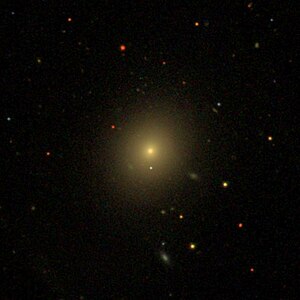NGC 3238
| Galaxy NGC 3238 |
|
|---|---|

|
|
| SDSS recording | |
| AladinLite | |
| Constellation | Big Bear |
|
Position equinox : J2000.0 , epoch : J2000.0 |
|
| Right ascension | 10 h 26 m 43.0 s |
| declination | + 57 ° 13 ′ 35 ″ |
| Appearance | |
| Morphological type | SA (r) 0 ^ 0 ^: |
| Brightness (visual) | 13.2 mag |
| Brightness (B-band) | 14.2 mag |
| Angular expansion | 1.4 ′ × 1.3 ′ |
| Position angle | 132 ° |
| Surface brightness | 13.7 mag / arcmin² |
| Physical data | |
| Redshift | 0.024580 ± 0.000103 |
| Radial velocity | 7369 ± 31 km / s |
|
Stroke distance v rad / H 0 |
(332 ± 23) x 10 6 ly (101.9 ± 7.1) Mpc |
| history | |
| discovery | William Herschel |
| Discovery date | April 8, 1793 |
| Catalog names | |
| NGC 3238 • UGC 5649 • PGC 30686 • CGCG 290-041 • MCG + 10-15-080 • 2MASX J10264304 + 5713353 • GC 2098 • H II 883 • h 708 • NSA 36947 | |
NGC 3238 is a lenticular galaxy of the Hubble type S0 in the constellation Great Bear in the northern sky . It is estimated to be 332 million light years from the Milky Way and about 135,000 light years in diameter.
In the same area of the sky are u. a. the galaxies NGC 3214 , NGC 3220 , NGC 3225 .
The object was discovered by Wilhelm Herschel on April 8, 1793 .
